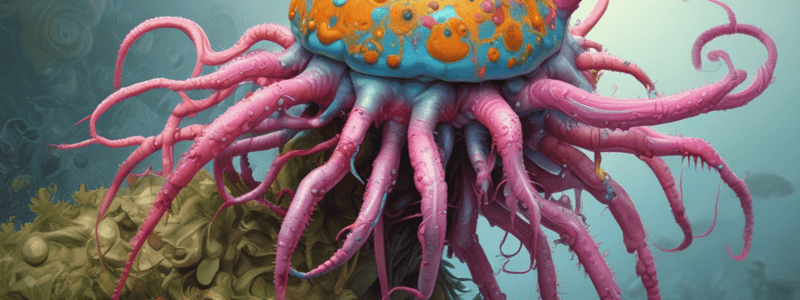Podcast
Questions and Answers
What is the typical size of an adult Acanthocephala?
What is the typical size of an adult Acanthocephala?
- 20cm
- 15cm
- 10cm (correct)
- 25cm
Which of the following is NOT a characteristic of Acanthocephala?
Which of the following is NOT a characteristic of Acanthocephala?
- Absorb nutrients from the host's digested gut contents
- Possess a retractable proboscis with hooks for attachment
- Lack a mouth and digestive system
- Have a simple life cycle with a broad spectrum host (correct)
What is the relationship between Acanthocephala and rotifers?
What is the relationship between Acanthocephala and rotifers?
- Acanthocephala and rotifers are sister groups (correct)
- Acanthocephala are a subphylum of rotifers
- Acanthocephala and rotifers are not related
- Acanthocephala are a type of freshwater zooplankton like rotifers
Where do adult Acanthocephala typically live?
Where do adult Acanthocephala typically live?
What is the life stage of Acanthocephala that is ingested to cause infection?
What is the life stage of Acanthocephala that is ingested to cause infection?
What is the diagnosis method for Acanthocephala infection?
What is the diagnosis method for Acanthocephala infection?
What is the term used to describe an organism that benefits from another organism without causing harm or benefit to it?
What is the term used to describe an organism that benefits from another organism without causing harm or benefit to it?
Which term describes an organism that lives within a host?
Which term describes an organism that lives within a host?
What is the abnormality described in the text regarding the life cycle of Acanthocephala found in mongoose and monkeys in St. Kitts?
What is the abnormality described in the text regarding the life cycle of Acanthocephala found in mongoose and monkeys in St. Kitts?
What is the reason given in the text for the abnormal Acanthocephala life cycle observed in St. Kitts?
What is the reason given in the text for the abnormal Acanthocephala life cycle observed in St. Kitts?
What is the intermediate host in the life cycle of Toxoplasma gondii?
What is the intermediate host in the life cycle of Toxoplasma gondii?
Which term refers to the preferred site within or on the host that provides optimal food for the parasite?
Which term refers to the preferred site within or on the host that provides optimal food for the parasite?
What does the term 'Hypobiosis' refer to in parasitology?
What does the term 'Hypobiosis' refer to in parasitology?
What is the purpose of a Paratenic Host in a parasite's life cycle?
What is the purpose of a Paratenic Host in a parasite's life cycle?
'Leucochloridium paradoxum' is associated with which characteristic behavior in its life cycle?
'Leucochloridium paradoxum' is associated with which characteristic behavior in its life cycle?
'Dirofilaria immitis' requires which organism as an Intermediate Host in its life cycle?
'Dirofilaria immitis' requires which organism as an Intermediate Host in its life cycle?
Which of the following host groups are known to be infected by Kudoa species?
Which of the following host groups are known to be infected by Kudoa species?
What is the primary concern with Kudoa species in undercooked fish?
What is the primary concern with Kudoa species in undercooked fish?
What is the primary symptom of whirling disease caused by Myxobolus cerebralis in juvenile salmonids?
What is the primary symptom of whirling disease caused by Myxobolus cerebralis in juvenile salmonids?
Which of the following is true about the host-parasite relationship between Myxobolus cerebralis and salmonids?
Which of the following is true about the host-parasite relationship between Myxobolus cerebralis and salmonids?
What is the relationship between Proliferative Kidney Disease (PKD) and increased water temperatures in Iceland?
What is the relationship between Proliferative Kidney Disease (PKD) and increased water temperatures in Iceland?
What is the defining characteristic of the Multivalvulida group of Kudoa?
What is the defining characteristic of the Multivalvulida group of Kudoa?
Which of the following is NOT a known host group for Kudoa species?
Which of the following is NOT a known host group for Kudoa species?
What is the primary mode of transmission for Myxobolus cerebralis, the causative agent of whirling disease in salmonids?
What is the primary mode of transmission for Myxobolus cerebralis, the causative agent of whirling disease in salmonids?
Which of the following statements about vectors (ectoparasites) is correct?
Which of the following statements about vectors (ectoparasites) is correct?
Which of the following is NOT a characteristic of trematodes?
Which of the following is NOT a characteristic of trematodes?
Which of the following pathogens is transmitted by deer ticks?
Which of the following pathogens is transmitted by deer ticks?
Which of the following statements about trematode eggs is correct?
Which of the following statements about trematode eggs is correct?
Which of the following is a characteristic of trematodes that relates to their zoonotic potential?
Which of the following is a characteristic of trematodes that relates to their zoonotic potential?
Which of the following statements about vectors (ectoparasites) is incorrect?
Which of the following statements about vectors (ectoparasites) is incorrect?
Which of the following is a characteristic of trematodes mentioned in the text?
Which of the following is a characteristic of trematodes mentioned in the text?
Which of the following is an example of a trematode mentioned in the text?
Which of the following is an example of a trematode mentioned in the text?
What is the most likely reason for the presence of cystacanths in the mongoose and monkeys at St Kitts?
What is the most likely reason for the presence of cystacanths in the mongoose and monkeys at St Kitts?
Which of the following statements is true about the abnormality related to the cystacanth infection of mongoose and monkeys at St Kitts?
Which of the following statements is true about the abnormality related to the cystacanth infection of mongoose and monkeys at St Kitts?
Which of the following statements about Myxozoa is incorrect?
Which of the following statements about Myxozoa is incorrect?
What is the primary function of the polar capsules in Myxozoa?
What is the primary function of the polar capsules in Myxozoa?
Which of the following statements about Myxozoa species is true?
Which of the following statements about Myxozoa species is true?
Which of the following statements about the classification of Myxozoa is correct?
Which of the following statements about the classification of Myxozoa is correct?
Flashcards are hidden until you start studying
Study Notes
Parasites: General Info
- Parasite: an organism that gets some or all of its food from the host, at the host's expense (only the parasite benefits)
- Endoparasite: lives within the host
- Ectoparasite: lives outside of the host
- Parasites can use the host for food, water, habitat, heat, transmission (and anything to help them survive)
Vectors (Ectoparasites)
- Fleas, ticks, lice, flies, and mosquitoes are examples of vectors that transmit pathogens
- Fleas and ticks carry pathogens in their salivary glands, transmitted through bites
- Examples of vector-borne diseases:
- Ticks transmit Ehrlichia and Anaplasma phagocytophilum
- Mosquitoes transmit heartworms (parasitic roundworms)
Trematode: General Info
- AKA: Digeneans, Digenean flukes, Aspidogastrea
- Endoparasites within Phylum Platyhelminthes
- Characterized by:
- Oral and ventral suckers
- Dorsoventrally flattened (leaf-like) body shape
- Lack an anus and use flame cells for waste removal
- Hermaphroditic, but can cross-reproduce
- No direct life cycle
- Broad host spectrum
- Almost always use gastropods (snails) as intermediate hosts
- Heavy eggs require sedimentation for diagnosis
- Definitive host (DH) is typically a predatory fish or sometimes birds, and can be zoonotic if metacercaria is eaten from the environment
Trematode: Examples
- Fasciola hepatica (common liver fluke or sheep liver fluke)
- Infects mammals, birds, amphibians, reptiles, and some fish
- Myxobolus cerebralis (whirling disease)
- Destroys cartilage in spinal column and cranium within juvenile salmonids, leading to death or lifelong deformity
- Spreads via live or frozen fish from Eurasia
- Kudoa (histozoic myxosporean)
- Infects marine fish skeletal muscle or organs
- Can cause gastrointestinal problems in humans if eaten in undercooked fish
Acanthocephala Phylum: General Info
- AKA: Thorny headed worms
- Lack mouth and digestive system, absorbing nutrients from the host's digested gut contents via their integument (skin)
- Size: up to 10cm
- Sister group to rotifers (freshwater zooplankton)
- Intermediate hosts (IH) are always invertebrates
- Adults live in the digestive tract (small intestines) and are not typically pathogenic
- Always have a complex life cycle and broad spectrum hosts
- Diagnosis: eggs in feces (sometimes sub-clinical)
Acanthocephala Phylum: Examples
- Found encysted within the muscle of mongoose and scrotum of monkeys
- Abnormalities:
- Cystacanths are only in the IH to await transmission to the DH
- IH are always invertebrates, but in this case, they were found in mongoose and monkeys
Epibiosis (Phoresis)
- Two organisms that are nutritionally independent of each other have a facultative relationship
- Epibiont: smaller organism using another for transport
- Basibiont: larger organism that carries the epibiont
- Example: stalked ciliate using copepod for transport
Commensalism
- Small symbiont eats for/benefits from larger symbiont, which is neither harmed nor benefited
- Example: flagellate eating unwanted bacteria off of fish
Studying That Suits You
Use AI to generate personalized quizzes and flashcards to suit your learning preferences.




